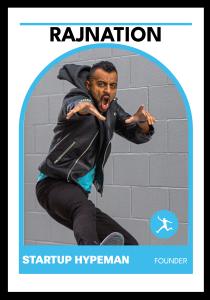The Startup Storytelling Reset: Rajiv Nathan on What Investors Actually Want to Hear
Hint: It’s not enough to be the best—you have to be the only.
At a recent pitch competition in Miami, one founder ditched the jargon and opened with a story: "Logistics lives and dies by the motto, ‘Time is money’”.
Judges leaned in. Investors asked to hear more.
That pitch—crafted with the help of Rajiv “RajNATION” Nathan—wasn’t packed with buzzwords. It was built to form an emotional bridge.
As the founder of Startup Hypeman, RajNATION is helping startups ditch generic jargon in favor of storytelling that actually resonates. His pitch philosophy—don’t be the best, be the only—has become a rallying cry for founders looking to create new categories, not just compete in crowded ones.
At events like Startup Grind’s Global Conference in Silicon Valley and Startup Mania in Miami—where several of his clients captivated investors and judges—and through his work with Series A down to pree-seed founders in Chicago, RajNATION is leading a much-needed reset in startup messaging: one that speaks human, not jargon.
“Founders get stuck trying to prove they’re better than the competition,” says RajNATION. “But investors aren’t looking for the next best version of something—they’re looking for something that feels new, necessary, and memorable. That starts with emotional clarity, not feature lists.”
So what gives RajNATION his unique insight into what startups need to succeed? In addition to serving as Chief Pitch Artist of Startup Hypeman, he’s also a rapper, MMA ring announcer and broadcaster, and yoga instructor. That means he’s been on just about every kind of stage imaginable—and knows what it takes to capture an audience, hold their attention, think on your feet, and deliver under pressure. It’s a background that gives him a deep understanding of the founder mindset and what it really takes to show up and stand out.
He also advises startups to speak like real people, not pitch decks.
“Get in touch with your customer-facing message and let that guide your investor pitch,” he says. “It's amazing how much further you'll get with an investor by showing them you know how to speak to your customers. For example, instead of leading with a statistic or market size, can you get them to feel the emotional pain? They want to see strong numbers and market potential—but they need to feel it matters first. Emotion gives context to your numbers, and numbers without context inherently don't carry emotion."
Hear more from RajNATION in an interview recorded live for Expert Connexions during Startup Grind’s Global Conference in Silicon Valley.
About Rajiv Nathan
Known as the Voice of Startup Culture, Rajiv 'RajNATION' Nathan is Founder & Chief Pitch Artist of Startup Hypeman, helping startups ensure a bad pitch doesn’t get in the way of a great product. He was named an "Agent of Change" by Huffington Post, has given a TED Talk, and been featured in Inc, Forbes, and more. He's also a hip hop artist, yoga instructor, and professional MMA announcer.
Startup Hypeman helps startups not just go to market, but become The GOAT to market through pitch and narrative development. Founders and CEOs at startups of all stages collaborate with us to convert their Vision into pitches for capital raises, customer acquisition, and category creation so their audience doesn’t acknowledge them as the best, they acknowledge them as the ONLY.
Learn more at www.startuphypeman.com and check out the podcast, The GOAT to Market Show on all streaming platforms.
About Expert Connexions
Expert Connexions is a YouTube interview series hosted by entrepreneur and marketing strategist Julie Holton Smith, featuring business leaders, innovators, and entrepreneurs from across the country. Learn more at youtube.com/@expertconnexions and mConnexions.com.
Julie Holton Smith
mConnexions
+1 517-208-2087
email us here
Legal Disclaimer:
EIN Presswire provides this news content "as is" without warranty of any kind. We do not accept any responsibility or liability for the accuracy, content, images, videos, licenses, completeness, legality, or reliability of the information contained in this article. If you have any complaints or copyright issues related to this article, kindly contact the author above.
Alex Miller Keeps Classic Country Flame Burning With Alan Jackson Song 'Secondhand Smoke'
Lala’s Place TV Launches YouTube Channel to Empower, Educate, and Entertain Young Learners Through Music and Animation
leagend RT200: A Professional Lithium Battery Tester Designed for Accurate, Reliable Diagnostics
Kalendarium
Więcej ważnych informacji
 Jedynka Newserii
Jedynka Newserii

 Jedynka Newserii
Jedynka Newserii

Prawo

Trwają dyskusje nad kształtem unijnego budżetu na lata 2028–2034. Mogą być rozbieżności w kwestii Funduszu Spójności czy dopłat dla rolników
Trwają prace nad wieloletnimi unijnymi ramami finansowymi (WRF), które określą priorytety wydatków UE na lata 2028–2034. W maju Parlament Europejski przegłosował rezolucję w sprawie swojego stanowiska w tej sprawie. Postulaty europarlamentarzystów mają zostać uwzględnione we wniosku Komisji Europejskiej w sprawie WRF, który zostanie opublikowany w lipcu 2025 roku. Wciąż jednak nie ma zgody miedzy państwami członkowskimi, m.in. w zakresie Funduszu Spójności czy budżetu na rolnictwo.
Konsument
35 proc. gospodarstw domowych nie stać na zakup mieszkania nawet na kredyt. Pomóc może wsparcie budownictwa społecznego i uwolnienie gruntów pod zabudowę

W Polsce co roku oddaje się do użytku ok. 200 tys. mieszkań, co oznacza, że w ciągu dekady teoretycznie potrzeby mieszkaniowe społeczeństwa mogłyby zostać zaspokojone. Jednak większość lokali budują deweloperzy na sprzedaż, a 35 proc. gospodarstw domowych nie stać na zakup nawet za pomocą kredytu. Jednocześnie ta grupa zarabia za dużo, by korzystać z mieszkania socjalnego i komunalnego. Zdaniem prof. Bartłomieja Marony z UEK zmniejszeniu skali problemu zaradzić może wyłącznie większa skala budownictwa społecznego zamiast wspierania kolejnymi programami zaciągania kredytów.
Problemy społeczne
Hejt w sieci dotyka coraz więcej dzieci w wieku szkolnym. Rzadko mówią o tym dorosłym

Coraz większa grupa dzieci zaczyna korzystać z internetu już w wieku siedmiu–ośmiu lat – wynika z raportu NASK „Nastolatki 3.0”. Wtedy też stykają się po raz pierwszy z hejtem, którego jest coraz więcej w mediach społecznościowych. Według raportu NASK ponad 2/3 młodych internautów uważa, że mowa nienawiści jest największym problemem w sieci. Co więcej, dzieci rzadko mówią o takich incydentach dorosłym, dlatego tym istotniejsze są narzędzia technologiczne służące ochronie najmłodszych.
Partner serwisu
Szkolenia

Akademia Newserii
Akademia Newserii to projekt, w ramach którego najlepsi polscy dziennikarze biznesowi, giełdowi oraz lifestylowi, a także szkoleniowcy z wieloletnim doświadczeniem dzielą się swoją wiedzą nt. pracy z mediami.








.gif)

 |
| |
| |
|